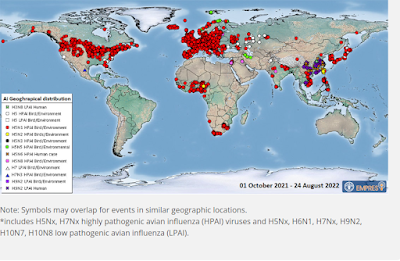#17,006
One of the things you notice first about the above FAO map showing global HPAI detections is the total lack of outbreaks reported in Central and South America, even though they are connected to the Northern Hemisphere by migratory flyways (see below).
Some of this is likely due to a lack of surveillance and reporting, but it took many years - until 2017 - for HPAI H5 to work its way down the African continent to become endemic in South Africa.
While most migratory birds travel from low to high latitudes in their (northern or southern) hemisphere, relatively few, it seems, are trans-equatorial travelers.
But a few do make that crossing, and given the growing prevalence of HPAI H5 in the Northern hemisphere, there are apt to be more opportunities for avian flu to expand southward. All of which puts Central and South America, along with Australia and New Zealand, at some risk.
South and Central America have not been completely devoid of avian flu (see PLoS One Avian influenza in Latin America: A systematic review of serological and molecular studies from 2000-2015), and in 2015 Belize reported multiple outbreaks of LPAI H5N2.
Yesterday the Central American country of Belize announced the detection of avian H5 in a commercial poultry farm, although its pathogenicity and n-type have not yet been determined (see BAHA notice below).
My thanks to Thijs Kuiken on Twitter for the head's up.
We should learn whether this is HPAI or LPAI in the next few days.


